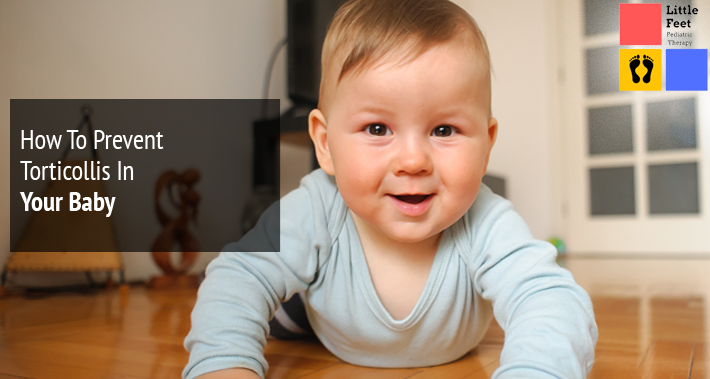
Many parents worry about the health and wellbeing of their newborns.
That’s especially true for first time parents.
However, the good news is that many pediatric conditions are preventable.
Little Feet Therapy is a pediatric therapy clinic specializing in physical therapy services for kids.
Our therapy team is trained in a variety of different specialties, including physical therapy for infant torticollis.
The good news is that torticollis, in most cases, isn’t painful and can be easy to treat.
But as Ben Franklin once said, an ounce of prevention is worth a pound of cure.
So this week, we’ll be talking about how to prevent torticollis.
Keep reading for more information.
What Is Torticollis?
First things first: what exactly is torticollis?
We’ve talked about torticollis on our pediatric therapy blog before.
In particular, we’ve spent time talking about some of the questions parents often have about torticollis, and some general treatment.
So, if you’re a regular reader, feel free to skip to the next section.
But if you’ve never heard of torticollis before, don’t worry, you’ve come to the right place.
Torticollis is a common childhood condition which affects your baby’s sternocleidomastoid muscles (SCM).
These muscles sit on either side of the neck and extend from behind your ears all the way to your collarbone.
Your SCM muscles support your neck as you turn your head from side to side.
In torticollis, one side becomes tight and stiff, making head and neck movements increasingly difficult.
As a result, babies with torticollis experience a chronic head tilt and have trouble using their neck’s full range of motion.
Babies with torticollis also commonly experience postural asymmetries since they favor one side of their body over the other.
Many potential factors contribute to the development of torticollis.
For instance, torticollis is sometimes congenital, meaning that your baby is born with the condition.
In these cases, common causes include atypical womb positioning and injuries that occur while in utero.
Torticollis may also develop after birth.
This is known as acquired torticollis.
Potential causes include post birth injuries or infections.
If your baby is dealing with torticollis, you may notice that they:
- Favor one side of their body over the other
- Have a deeper crease on one side of their neck
- Tilt their head in one direction
- Have trouble looking and turning their head in both directions
- Have trouble keeping their head in an upright, middle position
- Experience feeding difficulties, such as preferring one breast over the other
Without intervention, torticollis may cause additional complications, such as plagiocephaly aka “flat head syndrome”.
Fortunately, physical therapy can help correct both conditions.
However, early detection and intervention is important.
The earlier a child with torticollis starts physical therapy, the better the outcome.
What Are The Risk Factors For Torticollis?
We’ve briefly discussed the difference between congenital and acquired torticollis.
But what exactly are the risk factors for each?
Congenital torticollis is caused by many different factors.
For instance, babies born with a body length greater than 20.2 inches experience a higher prevalence of torticollis.
First born children are also at a greater risk.
Similarly, a variety of factors can cause acquired torticollis.
For example, babies born via the use of forceps or suction devices commonly develop torticollis.
Other factors include not enough tummy time and being placed in one position for long periods of time.
Finally, certain conditions may increase your baby’s risk of developing torticollis.
These include:
- Plagiocephaly
- Hip dysplasia
- Brachial plexus injuries
- Early motor delays
- Acid reflux
- Vision problems
Can Torticollis Be Prevented?
So, is torticollis preventable?
Well, it depends.
Some cases of congenital torticollis aren’t preventable, as babies are born with one side of their neck tighter than the other due to womb positioning or stresses during birth.
However, in many cases, you can help prevent acquired torticollis in your baby.
Let’s take a closer look at some examples.
1. Tummy Time
Tummy time provides your baby with several crucial benefits during their formative years.
For instance, it helps your baby develop and strengthen their head and neck muscles as well as the muscles in their arms and tummy.
You can help this by moving toys, a mirror, or just yourself from side to side in front of your baby while they are on their tummy.
This will not only provide them with entertainment to make tummy time more enjoyable, but it will also help them move, stretch, and strengthen their neck muscles.
2. Help Your Baby Look Around
Helping your baby look in all directions is another tip for preventing torticollis.
This discourages the use of one side of the neck over the other.
There are many ways you can help your baby look around as discussed above.
This can be done in sit sitting, while on their back, or while on their tummy.
3. Hold Your Baby On Different Sides
Holding your baby in a variety of positions is another great method for preventing torticollis.
This includes alternating holding positions, such as by using both arms, over both shoulders, etc.
Additionally, encourage the use of both sides while feeding, whether by encouraging feeding from both breasts or by bottle feeding in alternating directions.
4. Use A Mirror
Mirrors are excellent tools for torticollis prevention.
Position a mirror on one side of baby’s head before tapping it and saying, “Look, it’s [your baby’s name]!”.
Next, move the mirror to the other side and repeat this process.
5. Avoid Forcing Your Baby Into A Position
Staying in one position for extended periods of time is one of the most common causes of torticollis.
This typically occurs with excessive use of positioning devices, such as car seats, strollers, and baby swings.
While in these devices, your baby can’t move their head and neck in multiple directions.
Additionally, positioning devices encourage improper posture techniques, which may cause a head turn or tilt.
6. Change The Direction They Sleep In
Muscle strengthening also occurs while your baby is asleep.
That’s why regularly changing their sleeping positioning is so important.
Placing your baby’s head on alternating sides of their crib every night is an excellent method for preventing torticollis.
However, keep in mind that babies must always sleep on their backs.
This helps prevent sudden infant death syndrome (SIDS) as well as encourages muscle development.

What To Do If Your Baby Has Torticollis?
Now that you know a little bit more about preventing torticollis, you might wonder what you should do if your baby develops the condition.
At Little Feet Pediatric Therapy, we have a special interest in helping babies overcome torticollis.
Physical therapy focuses on reducing neck and head stiffness as well as correcting head tilts.
Your child’s therapists may use a variety of methods in accomplishing these goals.
This may include:
- Encouraging neck rotation
- Advising on environmental techniques for encouraging full range of neck motion, such as crib and toy placement
- Developing tummy time techniques that work for both you and your baby
- Utilizing manual therapy techniques to relax tight muscles
No two physical therapy plans for torticollis are exactly the same.
We always take your baby’s unique strengths and challenges into consideration when devising a physical therapy plan.
Speak to a physical therapist at Little Feet Pediatric Therapy to hear more about the specifics ways we can help you and your child.
Book Your Appointment With Little Feet Pediatric Therapy Today
Does your baby have trouble utilizing both sides of their neck?
Do they demonstrate a preference for one side of their body over the other?
If so, these are potential early signs of torticollis.
At Little Feet Pediatric Therapy, we can help you and your baby overcome these challenges.
Book your appointment with Little Feet Pediatric Therapy today.
► 3535 Randolph Rd, Charlotte, NC 28211
► 1331 H St NW Ste 200, Washington, DC 20005
► St. Louis, MO
► Raleigh, NC
Founded in 2019, Little Feet Therapy offers on site pediatric physical and occupational therapy treatments for children from 2 months to 18 years old with physical and developmental concerns. Our clinics focus on providing therapy in a child’s natural setting where your child is in familiar surroundings, it puts their mind at ease and helps them focus more on the work they’re doing with their pediatric therapist. Our therapists will work with your child at your home, at school, at daycare, or another place in the community where they feel most comfortable.